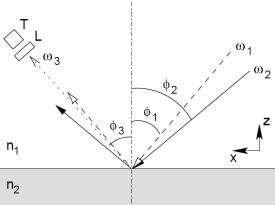Research
Surface Spectroscopy

Often, in scientific or technological areas governed by physicochemical principles-areas such as, adhesion, coatings, catalysis, cell biology, and biomedical implants-there are problems that involve the coming together of two immiscible substances. The boundary region at which the phases of such substances meet is defined as the interface. Observable interfacial phenomena are dictated by the nature and organization of molecules originating from each of the two phases and residing in the interface. In most instances, the latter is inferred from the former-for example, wettability studies and friction measurement may suggest the preference of certain types of molecules, and perhaps even their structure, at the interface. Knowledge of the underlying, molecular origins is important because the composition and architecture of molecules can be controlled by chemical synthesis; therefore, proven molecular mechanisms for interfacial phenomena are of great value in controlling the behavior of two substances at their mutual interface. However, because several buried or hidden interfaces (e.g., solid-solid and solid-liquid) are inaccessible, in situ, by conventional surface-science techniques that require vacuum, traditionally researchers have resorted to indirect and ex situ routes to obtain the molecular-level picture. In the last decade, we have used SFG to study polymer-air, polymer-liquid, polymer-polymer, and polymer-solid interfaces.
Recent Publications
Zhu, H; Dhinojwala, A. “Thermal Behavior of Long-Chain Alcohols on Sapphire Substrate.” Langmuir 2015, 31 (23), 6306–6313. 
Defante, A. P.; Burai, T. N.; Becker, M. L.; Dhinojwala, A. “Consequences of Water between Two Hydrophobic Surfaces on Adhesion and Wetting” Langmuir 2015, 31, 2398-2406. 
Dhopatkar, N; Park, J. H.; Chari, K.; Dhinojwala, A. “Adsorption and Viscoelastic Analysis of Polyelectrolyte-Surfactant Complexes on Charged Hydrophilic Surfaces” Langmuir 2015, 31, 1026-1037. 
Zhang, Y.; Anim-Danso, E.; Dhinojwala, A. “The Effect of Solid Surface on the Segregation and Melting of Salt Hydrates” J. Am. Chem. Soc. 2014, 136, 14811-14820 . 
Zha, K. C.; Zhu, H.; Dhinojwala, A.; Tsige, M. “Molecular Structure of Poly(methyl methacrylate) Surface II. Effect of Steroregularity Examined through All-atom Molecular Dynamics” Langmuir 2014, 30, 12775-12785. 
Prasad, S.; Zhu, H.; Kurian, A.; Badge, I.; Dhinojwala, A. “Interfacial Segregation in Polymer Blends Driven by Acid-Base Interactions” Langmuir 2013, 29, 15727-15731. 
Anim-Danso, E.; Zhang, Y.; Dhinojwala, A. “Freezing and Melting of Salt Hydrates Next to Solid Surfaces Probed by Infrared−Visible Sum Frequency Generation Spectroscopy” J. Am. Chem. Soc 2013, 135, 8496-8499. 
Anim-Danso, E.; Zhang, Y.; Alizadeh, A.; Dhinojwala, A. “Freezing of Water Next to Solid Surfaces Probed by Infrared−Visible Sum Frequency Generation Spectroscopy” J. Am. Chem. Soc 2013, 135, 2734-2740. 
Alizadeh, A.; Yamada, M.; Li, R.; Shang, W.; Otta, S.; Zhong, S.; Ge, L.; Dhinojwala, A.; Conway, K. R.; Bahadur, V.; Vinciquerra, A. J.; Stephen, B.; Blohm, M. L. “Dynamics of Ice Nucleation on Water Repellent Surfaces” Langmuir 2012, 28(6), 3180-3186. 
Hsu, P. Y.; Dhinojwala, A.; “Contact of Oil with Solid Surfaces in Aqueous Media Probed Using Sum Frequency Generation Spectroscopy” Langmuir 2012, 28(5), 2567-2573. 
Li, G.; Dhinojwala, A.; Yeganeh, M. S. “Interference Effect from Buried Interfaces Investigated by Angular-Dependent Infrared-Visible Sum Frequency Generation Technique” J. Phys. Chem. C 2011, 115(15), 7554-7561. 
Kurian, A.; Prasad, S.; Dhinojwala, A. “Unusual Surface Aging of Poly(dimethylsiloxane) Elastomers”Macromolecules 2010, 43, 2438-2443. 
Prasad, S.; Jiang, Z.; Sprung, M.; Sinha, S. K.; Dhinojwala, A. “Effect of Surface Freezing on Meniscus Relaxation in Side Chain Comb Polymers” Phys. Rev. Lett. 2010, 104, 137801.